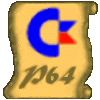Freezers
Freezing
Capturing
ISEPICking
Snapshotting
Memorydumping
Many words for the very same procedure and even though the C64 for sure was not the first machine being forced to immediately stop the currently running code and execute hackerish monitoring code instead it was a brilliant platform for it. The C64 expansion port offers all the lines which are required to force the CPU into a different memory mode, memory configs can be influenced and even DMA is available at the port. Future developments will probably show wether a whole secondary computer runs nicely in sync with a C64 and until now about anything was sooner or later becoming possible at the C64 expansion port.
Very early selfmade cartridges used the expansion port to allow running simple debugging and monitoring code whenever possible since kernal ROM modifications offered less space usually. These cartridges often came with ON/OFF switches and a reset button so inspecting the memory was possible while loosing some of the C64 RAM along with program counter and some (many) registers.
This situation was of course not really satisfactory so ways had to be found to dump the complete memory content and more important the status of the VIC chip, the CPU, the timers and color RAM as well to produce a theoretically perfect copy.
The first commercially sold cartridge using the freezing principles was ISEPIC quickly followed by Capture. ISEPIC is said to have been sold 20.000 times before going commercial. So there apparently was some demand but there was also a high demand for shorter loading times, basic extensions and improved printing functions.
The usual controversial discussions about the commercial availability of tools to backup your collection of original games especially arised on freeze cartridges of course. While parameter copiers and disk nibblers were not really as affected the cartridge discussion surely heated the interest and raised sales. Around 1987 most cartridges got updated and it has turned out that merging several functions and adding more features was the key to real commercial success in the end.
Using one of the many cartridges about anyone was able to quickly produce a more or less working copy of a game or application but on extremely many cases this was not the main purpose being served. Looking at the hundreds of thousands of disk images getting transferred nowadays there are not too many frozen programs to be found. It appears that in fact the freeze and edit functions have either supported and aided people on their creations or helped them understand problems on own and others code.
Few real numbers on overall freezer cartridge sales are known so it can only be guessed that there were more than five million of these handy carts being sold. It's likely less than ten million but even that number could be busted - we have no idea. It is sure that just the small cartridges such as ISEPIC, Capture, Power Cartridge and Freeze Frame easily go by one million though.
We will be trying to gather up some statistics soon about the usage of freezers on a superset of available disks, someday soon. Meanwhile we will require YOUR help to gather information and more binary content for the collection. Even already listed versions of many cartridges are welcome and appreciated. Please have a look at the Wantlist.
Whopping 25 years later we are picking up all these cartridges and suddenly want to emulate and use them! Hell, what happened? Not much really. Over the years there have been discussions concerning various aspects of cartridges, kernals and other extensions again and again while finding additional information on these topics was getting more and more painful.
Here we'll fetch und publish the information we find on the target areas we selected. Enjoy.
The ReplayResources team.












